+ データを開く
データを開く
- 基本情報
基本情報
| 登録情報 | データベース: PDB / ID: 5tby | ||||||||||||||||||||||||
|---|---|---|---|---|---|---|---|---|---|---|---|---|---|---|---|---|---|---|---|---|---|---|---|---|---|
| タイトル | HUMAN BETA CARDIAC HEAVY MEROMYOSIN INTERACTING-HEADS MOTIF OBTAINED BY HOMOLOGY MODELING (USING SWISS-MODEL) OF HUMAN SEQUENCE FROM APHONOPELMA HOMOLOGY MODEL (PDB-3JBH), RIGIDLY FITTED TO HUMAN BETA-CARDIAC NEGATIVELY STAINED THICK FILAMENT 3D-RECONSTRUCTION (EMD-2240) | ||||||||||||||||||||||||
 要素 要素 |
| ||||||||||||||||||||||||
 キーワード キーワード |  CONTRACTILE PROTEIN / CONTRACTILE PROTEIN /  CONTRACTILE PROTEIN Hypertrophic or dilated cardiomyopathy beta-cardiac myosin II Myosin interacting-heads motif CONTRACTILE PROTEIN Hypertrophic or dilated cardiomyopathy beta-cardiac myosin II Myosin interacting-heads motif | ||||||||||||||||||||||||
| 機能・相同性 |  機能・相同性情報 機能・相同性情報myosin II heavy chain binding / muscle cell fate specification / regulation of slow-twitch skeletal muscle fiber contraction / regulation of the force of skeletal muscle contraction / cardiac myofibril / muscle myosin complex / regulation of striated muscle contraction / cardiac myofibril assembly / muscle filament sliding / regulation of the force of heart contraction ...myosin II heavy chain binding / muscle cell fate specification / regulation of slow-twitch skeletal muscle fiber contraction / regulation of the force of skeletal muscle contraction / cardiac myofibril / muscle myosin complex / regulation of striated muscle contraction / cardiac myofibril assembly / muscle filament sliding / regulation of the force of heart contraction / transition between fast and slow fiber / myosin filament /  myosin II complex / adult heart development / cardiac muscle hypertrophy in response to stress / Striated Muscle Contraction / positive regulation of ATP-dependent activity / I band / myosin II complex / adult heart development / cardiac muscle hypertrophy in response to stress / Striated Muscle Contraction / positive regulation of ATP-dependent activity / I band /  myosin complex / A band / structural constituent of muscle / sarcomere organization / microfilament motor activity / ventricular cardiac muscle tissue morphogenesis / myosin complex / A band / structural constituent of muscle / sarcomere organization / microfilament motor activity / ventricular cardiac muscle tissue morphogenesis /  myofibril / myofibril /  myosin heavy chain binding / myosin heavy chain binding /  heart contraction / positive regulation of the force of heart contraction / skeletal muscle contraction / actin monomer binding / striated muscle contraction / heart contraction / positive regulation of the force of heart contraction / skeletal muscle contraction / actin monomer binding / striated muscle contraction /  stress fiber / ATP metabolic process / cardiac muscle contraction / stress fiber / ATP metabolic process / cardiac muscle contraction /  regulation of heart rate / regulation of heart rate /  sarcomere / sarcomere /  muscle contraction / negative regulation of cell growth / Z disc / muscle contraction / negative regulation of cell growth / Z disc /  actin filament binding / actin filament binding /  heart development / heart development /  細胞骨格 / 細胞骨格 /  calmodulin binding / calmodulin binding /  calcium ion binding / calcium ion binding /  ATP binding / ATP binding /  細胞質基質 / 細胞質基質 /  細胞質 細胞質類似検索 - 分子機能 | ||||||||||||||||||||||||
| 生物種 |   Homo sapiens (ヒト) Homo sapiens (ヒト) | ||||||||||||||||||||||||
| 手法 |  電子顕微鏡法 / 電子顕微鏡法 /  単粒子再構成法 / 単粒子再構成法 /  クライオ電子顕微鏡法 / 解像度: 20 Å クライオ電子顕微鏡法 / 解像度: 20 Å | ||||||||||||||||||||||||
 データ登録者 データ登録者 | ALAMO, L. / WARE, J.S. / PINTO, A. / GILLILAN, R.E. / SEIDMAN, J.G. / SEIDMAN, C.E. / PADRON, R. | ||||||||||||||||||||||||
| 資金援助 |  米国, 米国,  フランス, フランス,  英国, 7件 英国, 7件
| ||||||||||||||||||||||||
 引用 引用 |  ジャーナル: J Mol Biol / 年: 2016 ジャーナル: J Mol Biol / 年: 2016タイトル: Conserved Intramolecular Interactions Maintain Myosin Interacting-Heads Motifs Explaining Tarantula Muscle Super-Relaxed State Structural Basis. 著者: Lorenzo Alamo / Dan Qi / Willy Wriggers / Antonio Pinto / Jingui Zhu / Aivett Bilbao / Richard E Gillilan / Songnian Hu / Raúl Padrón /    要旨: Tarantula striated muscle is an outstanding system for understanding the molecular organization of myosin filaments. Three-dimensional reconstruction based on cryo-electron microscopy images and ...Tarantula striated muscle is an outstanding system for understanding the molecular organization of myosin filaments. Three-dimensional reconstruction based on cryo-electron microscopy images and single-particle image processing revealed that, in a relaxed state, myosin molecules undergo intramolecular head-head interactions, explaining why head activity switches off. The filament model obtained by rigidly docking a chicken smooth muscle myosin structure to the reconstruction was improved by flexibly fitting an atomic model built by mixing structures from different species to a tilt-corrected 2-nm three-dimensional map of frozen-hydrated tarantula thick filament. We used heavy and light chain sequences from tarantula myosin to build a single-species homology model of two heavy meromyosin interacting-heads motifs (IHMs). The flexibly fitted model includes previously missing loops and shows five intramolecular and five intermolecular interactions that keep the IHM in a compact off structure, forming four helical tracks of IHMs around the backbone. The residues involved in these interactions are oppositely charged, and their sequence conservation suggests that IHM is present across animal species. The new model, PDB 3JBH, explains the structural origin of the ATP turnover rates detected in relaxed tarantula muscle by ascribing the very slow rate to docked unphosphorylated heads, the slow rate to phosphorylated docked heads, and the fast rate to phosphorylated undocked heads. The conservation of intramolecular interactions across animal species and the presence of IHM in bilaterians suggest that a super-relaxed state should be maintained, as it plays a role in saving ATP in skeletal, cardiac, and smooth muscles. #1:  ジャーナル: J Mol Biol / 年: 2008 ジャーナル: J Mol Biol / 年: 2008タイトル: Three-dimensional reconstruction of tarantula myosin filaments suggests how phosphorylation may regulate myosin activity. 著者: Lorenzo Alamo / Willy Wriggers / Antonio Pinto / Fulvia Bártoli / Leiria Salazar / Fa-Qing Zhao / Roger Craig / Raúl Padrón /  要旨: Muscle contraction involves the interaction of the myosin heads of the thick filaments with actin subunits of the thin filaments. Relaxation occurs when this interaction is blocked by molecular ...Muscle contraction involves the interaction of the myosin heads of the thick filaments with actin subunits of the thin filaments. Relaxation occurs when this interaction is blocked by molecular switches on these filaments. In many muscles, myosin-linked regulation involves phosphorylation of the myosin regulatory light chains (RLCs). Electron microscopy of vertebrate smooth muscle myosin molecules (regulated by phosphorylation) has provided insight into the relaxed structure, revealing that myosin is switched off by intramolecular interactions between its two heads, the free head and the blocked head. Three-dimensional reconstruction of frozen-hydrated specimens revealed that this asymmetric head interaction is also present in native thick filaments of tarantula striated muscle. Our goal in this study was to elucidate the structural features of the tarantula filament involved in phosphorylation-based regulation. A new reconstruction revealed intra- and intermolecular myosin interactions in addition to those seen previously. To help interpret the interactions, we sequenced the tarantula RLC and fitted an atomic model of the myosin head that included the predicted RLC atomic structure and an S2 (subfragment 2) crystal structure to the reconstruction. The fitting suggests one intramolecular interaction, between the cardiomyopathy loop of the free head and its own S2, and two intermolecular interactions, between the cardiac loop of the free head and the essential light chain of the blocked head and between the Leu305-Gln327 interaction loop of the free head and the N-terminal fragment of the RLC of the blocked head. These interactions, added to those previously described, would help switch off the thick filament. Molecular dynamics simulations suggest how phosphorylation could increase the helical content of the RLC N-terminus, weakening these interactions, thus releasing both heads and activating the thick filament. #2:  ジャーナル: J Mol Biol / 年: 2016 ジャーナル: J Mol Biol / 年: 2016タイトル: Conserved Intramolecular Interactions Maintain Myosin Interacting-Heads Motifs Explaining Tarantula Muscle Super-Relaxed State Structural Basis. 著者: Lorenzo Alamo / Dan Qi / Willy Wriggers / Antonio Pinto / Jingui Zhu / Aivett Bilbao / Richard E Gillilan / Songnian Hu / Raúl Padrón /    要旨: Tarantula striated muscle is an outstanding system for understanding the molecular organization of myosin filaments. Three-dimensional reconstruction based on cryo-electron microscopy images and ...Tarantula striated muscle is an outstanding system for understanding the molecular organization of myosin filaments. Three-dimensional reconstruction based on cryo-electron microscopy images and single-particle image processing revealed that, in a relaxed state, myosin molecules undergo intramolecular head-head interactions, explaining why head activity switches off. The filament model obtained by rigidly docking a chicken smooth muscle myosin structure to the reconstruction was improved by flexibly fitting an atomic model built by mixing structures from different species to a tilt-corrected 2-nm three-dimensional map of frozen-hydrated tarantula thick filament. We used heavy and light chain sequences from tarantula myosin to build a single-species homology model of two heavy meromyosin interacting-heads motifs (IHMs). The flexibly fitted model includes previously missing loops and shows five intramolecular and five intermolecular interactions that keep the IHM in a compact off structure, forming four helical tracks of IHMs around the backbone. The residues involved in these interactions are oppositely charged, and their sequence conservation suggests that IHM is present across animal species. The new model, PDB 3JBH, explains the structural origin of the ATP turnover rates detected in relaxed tarantula muscle by ascribing the very slow rate to docked unphosphorylated heads, the slow rate to phosphorylated docked heads, and the fast rate to phosphorylated undocked heads. The conservation of intramolecular interactions across animal species and the presence of IHM in bilaterians suggest that a super-relaxed state should be maintained, as it plays a role in saving ATP in skeletal, cardiac, and smooth muscles. #3:  ジャーナル: Proc Natl Acad Sci U S A / 年: 2013 ジャーナル: Proc Natl Acad Sci U S A / 年: 2013タイトル: Atomic model of the human cardiac muscle myosin filament. 著者: Hind A Al-Khayat / Robert W Kensler / John M Squire / Steven B Marston / Edward P Morris /  要旨: Of all the myosin filaments in muscle, the most important in terms of human health, and so far the least studied, are those in the human heart. Here we report a 3D single-particle analysis of ...Of all the myosin filaments in muscle, the most important in terms of human health, and so far the least studied, are those in the human heart. Here we report a 3D single-particle analysis of electron micrograph images of negatively stained myosin filaments isolated from human cardiac muscle in the normal (undiseased) relaxed state. The resulting 28-Å resolution 3D reconstruction shows axial and azimuthal (no radial) myosin head perturbations within the 429-Å axial repeat, with rotations between successive 132 Å-, 148 Å-, and 149 Å-spaced crowns of heads close to 60°, 35°, and 25° (all would be 40° in an unperturbed three-stranded helix). We have defined the myosin head atomic arrangements within the three crown levels and have modeled the organization of myosin subfragment 2 and the possible locations of the 39 Å-spaced domains of titin and the cardiac isoform of myosin-binding protein-C on the surface of the myosin filament backbone. Best fits were obtained with head conformations on all crowns close to the structure of the two-headed myosin molecule of vertebrate chicken smooth muscle in the dephosphorylated relaxed state. Individual crowns show differences in head-pair tilts and subfragment 2 orientations, which, together with the observed perturbations, result in different intercrown head interactions, including one not reported before. Analysis of the interactions between the myosin heads, the cardiac isoform of myosin-binding protein-C, and titin will aid in understanding of the structural effects of mutations in these proteins known to be associated with human cardiomyopathies. #4: ジャーナル: Electrophoresis / 年: 1997 タイトル: SWISS-MODEL and the Swiss-PdbViewer: an environment for comparative protein modeling. 著者: N Guex / M C Peitsch /  要旨: Comparative protein modeling is increasingly gaining interest since it is of great assistance during the rational design of mutagenesis experiments. The availability of this method, and the resulting ...Comparative protein modeling is increasingly gaining interest since it is of great assistance during the rational design of mutagenesis experiments. The availability of this method, and the resulting models, has however been restricted by the availability of expensive computer hardware and software. To overcome these limitations, we have developed an environment for comparative protein modeling that consists of SWISS-MODEL, a server for automated comparative protein modeling and of the SWISS-PdbViewer, a sequence to structure workbench. The Swiss-PdbViewer not only acts as a client for SWISS-MODEL, but also provides a large selection of structure analysis and display tools. In addition, we provide the SWISS-MODEL Repository, a database containing more than 3500 automatically generated protein models. By making such tools freely available to the scientific community, we hope to increase the use of protein structures and models in the process of experiment design. #5: ジャーナル: Nucleic Acids Res / 年: 2003 タイトル: SWISS-MODEL: An automated protein homology-modeling server. 著者: Torsten Schwede / Jürgen Kopp / Nicolas Guex / Manuel C Peitsch /  要旨: SWISS-MODEL (http://swissmodel.expasy.org) is a server for automated comparative modeling of three-dimensional (3D) protein structures. It pioneered the field of automated modeling starting in 1993 ...SWISS-MODEL (http://swissmodel.expasy.org) is a server for automated comparative modeling of three-dimensional (3D) protein structures. It pioneered the field of automated modeling starting in 1993 and is the most widely-used free web-based automated modeling facility today. In 2002 the server computed 120 000 user requests for 3D protein models. SWISS-MODEL provides several levels of user interaction through its World Wide Web interface: in the 'first approach mode' only an amino acid sequence of a protein is submitted to build a 3D model. Template selection, alignment and model building are done completely automated by the server. In the 'alignment mode', the modeling process is based on a user-defined target-template alignment. Complex modeling tasks can be handled with the 'project mode' using DeepView (Swiss-PdbViewer), an integrated sequence-to-structure workbench. All models are sent back via email with a detailed modeling report. WhatCheck analyses and ANOLEA evaluations are provided optionally. The reliability of SWISS-MODEL is continuously evaluated in the EVA-CM project. The SWISS-MODEL server is under constant development to improve the successful implementation of expert knowledge into an easy-to-use server. #6: ジャーナル: Bioinformatics / 年: 2006 タイトル: The SWISS-MODEL workspace: a web-based environment for protein structure homology modelling. 著者: Konstantin Arnold / Lorenza Bordoli / Jürgen Kopp / Torsten Schwede /  要旨: MOTIVATION: Homology models of proteins are of great interest for planning and analysing biological experiments when no experimental three-dimensional structures are available. Building homology ...MOTIVATION: Homology models of proteins are of great interest for planning and analysing biological experiments when no experimental three-dimensional structures are available. Building homology models requires specialized programs and up-to-date sequence and structural databases. Integrating all required tools, programs and databases into a single web-based workspace facilitates access to homology modelling from a computer with web connection without the need of downloading and installing large program packages and databases. RESULTS: SWISS-MODEL workspace is a web-based integrated service dedicated to protein structure homology modelling. It assists and guides the user in building protein homology models at different ...RESULTS: SWISS-MODEL workspace is a web-based integrated service dedicated to protein structure homology modelling. It assists and guides the user in building protein homology models at different levels of complexity. A personal working environment is provided for each user where several modelling projects can be carried out in parallel. Protein sequence and structure databases necessary for modelling are accessible from the workspace and are updated in regular intervals. Tools for template selection, model building and structure quality evaluation can be invoked from within the workspace. Workflow and usage of the workspace are illustrated by modelling human Cyclin A1 and human Transmembrane Protease 3. AVAILABILITY: The SWISS-MODEL workspace can be accessed freely at http://swissmodel.expasy.org/workspace/ | ||||||||||||||||||||||||
| 履歴 |
| ||||||||||||||||||||||||
| Remark 0 | This entry reflects an alternative modeling of the original data in 3JBH, determined by ALAMO, L., ...This entry reflects an alternative modeling of the original data in 3JBH, determined by ALAMO, L., QI, D., WRIGGERS, W., PINTO, A., ZHU, J., BILBAO, A., GILLILAN, R.E., HU, S., PADRON, R. |
- 構造の表示
構造の表示
| ムービー |
 ムービービューア ムービービューア |
|---|---|
| 構造ビューア | 分子:  Molmil Molmil Jmol/JSmol Jmol/JSmol |
- ダウンロードとリンク
ダウンロードとリンク
- ダウンロード
ダウンロード
| PDBx/mmCIF形式 |  5tby.cif.gz 5tby.cif.gz | 488.5 KB | 表示 |  PDBx/mmCIF形式 PDBx/mmCIF形式 |
|---|---|---|---|---|
| PDB形式 |  pdb5tby.ent.gz pdb5tby.ent.gz | 388.1 KB | 表示 |  PDB形式 PDB形式 |
| PDBx/mmJSON形式 |  5tby.json.gz 5tby.json.gz | ツリー表示 |  PDBx/mmJSON形式 PDBx/mmJSON形式 | |
| その他 |  その他のダウンロード その他のダウンロード |
-検証レポート
| アーカイブディレクトリ |  https://data.pdbj.org/pub/pdb/validation_reports/tb/5tby https://data.pdbj.org/pub/pdb/validation_reports/tb/5tby ftp://data.pdbj.org/pub/pdb/validation_reports/tb/5tby ftp://data.pdbj.org/pub/pdb/validation_reports/tb/5tby | HTTPS FTP |
|---|
-関連構造データ
| 関連構造データ |  2240M M: このデータのモデリングに利用したマップデータ |
|---|---|
| 類似構造データ |
- リンク
リンク
- 集合体
集合体
| 登録構造単位 | 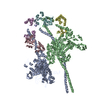
|
|---|---|
| 1 |
|
| 対称性 | らせん対称: (Num. of operations: 3 / Rise per n subunits: 145 Å / Rotation per n subunits: 30 °) |
- 要素
要素
| #1: タンパク質 |  ミオシン / Myosin heavy chain 7 / Myosin heavy chain slow isoform / MyHC-slow / Myosin heavy chain / cardiac ...Myosin heavy chain 7 / Myosin heavy chain slow isoform / MyHC-slow / Myosin heavy chain / cardiac muscle beta isoform / MyHC-beta ミオシン / Myosin heavy chain 7 / Myosin heavy chain slow isoform / MyHC-slow / Myosin heavy chain / cardiac ...Myosin heavy chain 7 / Myosin heavy chain slow isoform / MyHC-slow / Myosin heavy chain / cardiac muscle beta isoform / MyHC-beta分子量: 223445.984 Da / 分子数: 2 / 断片: SUBFRAGMENT 1(S1) / 由来タイプ: 天然 詳細: MYOSIN 2 HEAVY CHAIN, VENTRICULAR CARDIAC MUSCLE, FREE HEAD HOMOLOGY MODEL OF HUMAN BETA CARDIAC HEAVY MEROMYOSIN INTERACTING-HEADS MOTIF 由来: (天然)   Homo sapiens (ヒト) / 参照: UniProt: P12883 Homo sapiens (ヒト) / 参照: UniProt: P12883#2: タンパク質 |  / Cardiac myosin light chain 1 / CMLC1 / Myosin light chain 1 / slow-twitch muscle B/ventricular ...Cardiac myosin light chain 1 / CMLC1 / Myosin light chain 1 / slow-twitch muscle B/ventricular isoform / MLC1SB / Ventricular myosin alkali light chain / Ventricular myosin light chain 1 / VLCl / Ventricular/slow twitch myosin alkali light chain / MLC-lV/sb / Cardiac myosin light chain 1 / CMLC1 / Myosin light chain 1 / slow-twitch muscle B/ventricular ...Cardiac myosin light chain 1 / CMLC1 / Myosin light chain 1 / slow-twitch muscle B/ventricular isoform / MLC1SB / Ventricular myosin alkali light chain / Ventricular myosin light chain 1 / VLCl / Ventricular/slow twitch myosin alkali light chain / MLC-lV/sb分子量: 21962.068 Da / 分子数: 2 / 由来タイプ: 天然 詳細: MYOSIN 2 ESSENTIAL LIGHT CHAIN, VENTRICULAR CARDIAC MUSCLE, FREE (CHAIN C) AND BLOCKED (CHAIN D) HEAD HOMOLOGY MODEL OF HUMAN BETA CARDIAC HEAVY MEROMYOSIN INTERACTING-HEADS MOTIF 由来: (天然)   Homo sapiens (ヒト) / 参照: UniProt: P08590 Homo sapiens (ヒト) / 参照: UniProt: P08590#3: タンパク質 | 分子量: 18813.273 Da / 分子数: 2 / 由来タイプ: 天然 詳細: MYOSIN 2 REGULATORY LIGHT CHAIN, VENTRICULAR CARDIAC MUSCLE, FREE (CHAIN E) AND BLOCKED (CHAIN F) HEAD HOMOLOGY MODEL OF HUMAN BETA CARDIAC HEAVY MEROMYOSIN INTERACTING-HEADS MOTIF 由来: (天然)   Homo sapiens (ヒト) / 参照: UniProt: P10916 Homo sapiens (ヒト) / 参照: UniProt: P10916 |
|---|
-実験情報
-実験
| 実験 | 手法:  電子顕微鏡法 電子顕微鏡法 |
|---|---|
| EM実験 | 試料の集合状態: FILAMENT / 3次元再構成法:  単粒子再構成法 単粒子再構成法 |
- 試料調製
試料調製
| 構成要素 | 名称: MYOSIN THICK FILAMENTS TARANTULA STRIATED MUSCLE / タイプ: TISSUE 詳細: THE ATOMIC MODEL CONSIST OF ONE INTERACTING-HEADS MOTIF, FORMED BY TWO HEAVY MEROMYOSIN (S1 MYOSIN HEAD WITH A SEGMENT OF S2 AND ESSENTIAL AND REGULATORY LIGHT CHAINS) SO CALLED BLOCKED AND ...詳細: THE ATOMIC MODEL CONSIST OF ONE INTERACTING-HEADS MOTIF, FORMED BY TWO HEAVY MEROMYOSIN (S1 MYOSIN HEAD WITH A SEGMENT OF S2 AND ESSENTIAL AND REGULATORY LIGHT CHAINS) SO CALLED BLOCKED AND FREE HEADS, THE HOMOLOGY MODEL IS BASED ON TARANTULA STRIATED MUSCLE MODEL STRUCTURE 3JBH. THIS MODEL WAS RIGIDLY DOCKED TO A TARANTULA 3D MAP (EMD-1950) AND ALSO AGAINST HUMAN BETA-CARDIAC NEGATIVELY STAINED THICK FILAMENT 2.8 NM RESOLUTION 3D-RECONSTRUCTION (EMD-2240) Entity ID: all / 由来: NATURAL | |||||||||||||||||||||||||||||||||||
|---|---|---|---|---|---|---|---|---|---|---|---|---|---|---|---|---|---|---|---|---|---|---|---|---|---|---|---|---|---|---|---|---|---|---|---|---|
| 由来(天然) | 生物種:   Aphonopelma (クモ) / 細胞内の位置: SARCOPLASM / 器官: LEG / Organelle Aphonopelma (クモ) / 細胞内の位置: SARCOPLASM / 器官: LEG / Organelle : THICK FILAMENTS / 組織: MUSCLE : THICK FILAMENTS / 組織: MUSCLE | |||||||||||||||||||||||||||||||||||
| 緩衝液 | pH: 7 | |||||||||||||||||||||||||||||||||||
| 緩衝液成分 |
| |||||||||||||||||||||||||||||||||||
| 試料 | 包埋: NO / シャドウイング: NO / 染色 : NO / 凍結 : NO / 凍結 : YES : YES詳細: A 6 ul aliquot of native purified tarantula thick filaments suspension (Hidalgo et al. 2001). | |||||||||||||||||||||||||||||||||||
| 試料支持 | 詳細: Holey carbon grids had been rendered hydrophilic by glow discharge in n-amylamine vapor for 3 minutes before use. グリッドの材料: COPPER / グリッドのサイズ: 400 divisions/in. / グリッドのタイプ: Quantifoil | |||||||||||||||||||||||||||||||||||
急速凍結 | 装置: HOMEMADE PLUNGER / 凍結剤: ETHANE / 湿度: 80 % / 凍結前の試料温度: 296 K 詳細: PLUNGING IN A LIQUID ETHANE COOLED BY LIQUID NITROGEN. BLOTTING WAS PERFORMED FROM ONE SIDE OF THE GRID TILL A THIN SAMPLE FILM ON IT USING WHATMAN NO. 42 FILTER PAPER, THEN THE GRID WAS ...詳細: PLUNGING IN A LIQUID ETHANE COOLED BY LIQUID NITROGEN. BLOTTING WAS PERFORMED FROM ONE SIDE OF THE GRID TILL A THIN SAMPLE FILM ON IT USING WHATMAN NO. 42 FILTER PAPER, THEN THE GRID WAS IMMEDIATELY PLUNGED UNDER GRAVITY INTO LIQUID ETHANE COOLED BY LIQUID NITROGEN. GRIDS WERE STORED UNDER LIQUID NITROGEN. |
- 電子顕微鏡撮影
電子顕微鏡撮影
| 顕微鏡 | モデル: FEI/PHILIPS CM120T 詳細: Holey carbon grids Cryopreserved in Liquid ethane were observed in a Philips CM120 electron microscope under low dose conditions. Only filaments on thin carbon over holes were photographed |
|---|---|
| 電子銃 | 電子線源 : LAB6 / 加速電圧: 120 kV / 照射モード: FLOOD BEAM : LAB6 / 加速電圧: 120 kV / 照射モード: FLOOD BEAM |
| 電子レンズ | モード: BRIGHT FIELD Bright-field microscopy / 倍率(公称値): 35000 X / 倍率(補正後): 35000 X / 最大 デフォーカス(公称値): 1950 nm / 最小 デフォーカス(公称値): 1950 nm / Calibrated defocus min: 1950 nm / 最大 デフォーカス(補正後): 1950 nm / Cs Bright-field microscopy / 倍率(公称値): 35000 X / 倍率(補正後): 35000 X / 最大 デフォーカス(公称値): 1950 nm / 最小 デフォーカス(公称値): 1950 nm / Calibrated defocus min: 1950 nm / 最大 デフォーカス(補正後): 1950 nm / Cs : 2 mm / アライメント法: BASIC : 2 mm / アライメント法: BASIC |
| 試料ホルダ | 凍結剤: NITROGEN / 試料ホルダーモデル: GATAN LIQUID NITROGEN / 最高温度: 90 K / 最低温度: 88 K |
| 撮影 | 電子線照射量: 9 e/Å2 / フィルム・検出器のモデル: KODAK SO-163 FILM / 実像数: 500 詳細: Low-dose electron micrographs of 1008 frozen-hydrated thick filaments halves ere digitized at 0.248 nm per pixel using a Nikon Super Coolscan 8000 ED scanner. |
| 画像スキャン | サンプリングサイズ: 8.47 µm / 横: 250 / 縦: 250 |
- 解析
解析
| EMソフトウェア |
| |||||||||||||||||||||||||||||||||||
|---|---|---|---|---|---|---|---|---|---|---|---|---|---|---|---|---|---|---|---|---|---|---|---|---|---|---|---|---|---|---|---|---|---|---|---|---|
| 画像処理 | 詳細: Three-dimensional single particle reconstruction was carried out by a modification of the IHRSR method, using SPIDER. Low-dose electron micrographs of 1008 frozen-hydrated thick filaments ...詳細: Three-dimensional single particle reconstruction was carried out by a modification of the IHRSR method, using SPIDER. Low-dose electron micrographs of 1008 frozen-hydrated thick filaments halves where digitized at 0.248 nm per pixel using a Nikon Super Coolscan 8000 ED scanner. Filaments were aligned with the bare zone at the top, to ensure correct polarity in subsequent steps. | |||||||||||||||||||||||||||||||||||
CTF補正 | タイプ: NONE | |||||||||||||||||||||||||||||||||||
| 粒子像の選択 | 選択した粒子像数: 15504 詳細: A total of 15,504 segments, each 62 nm long, with an overlap of 55.8 nm, and containing aprox. 40,000 unique pairs of interacting myosin heads went into the reconstruction. | |||||||||||||||||||||||||||||||||||
| 対称性 | 点対称性 : C4 (4回回転対称 : C4 (4回回転対称 ) ) | |||||||||||||||||||||||||||||||||||
3次元再構成 | 解像度: 20 Å / 解像度の算出法: FSC 0.5 CUT-OFF / 粒子像の数: 10700 / アルゴリズム: BACK PROJECTION 詳細: For projection matching, giving a total of 4,095 projections (13 tilted projections plus-minus 12 deg. every 2deg., 45 reference rotated projections (0-90 degrees, 2deg. rotation angle), and ...詳細: For projection matching, giving a total of 4,095 projections (13 tilted projections plus-minus 12 deg. every 2deg., 45 reference rotated projections (0-90 degrees, 2deg. rotation angle), and 7 image axial shifts of 2.2 nm. The resulting 3D-map combines about 10,700 out of 15,504 filament segments, a yield of 69 percent of included segments. There are 4 helices of myosin heads, rotated 30 degrees, every 145 Angstroms. The filament segments were selected based on visual judgement of good helical order. クラス平均像の数: 4095 / 対称性のタイプ: POINT | |||||||||||||||||||||||||||||||||||
| 原子モデル構築 | プロトコル: RIGID BODY FIT / 空間: REAL / Target criteria: CORRELATION COEFFICIENT | |||||||||||||||||||||||||||||||||||
| 原子モデル構築 |
| |||||||||||||||||||||||||||||||||||
| 精密化 | 最高解像度: 20 Å |
 ムービー
ムービー コントローラー
コントローラー





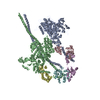
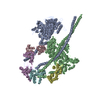
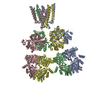
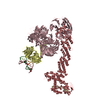
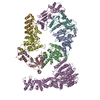
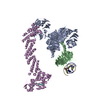
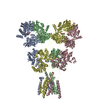

 PDBj
PDBj







